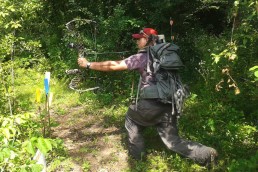GFP Asks Landowners and Hunters to Report Dead Deer
SHARE THIS POST
The South Dakota Game, Fish and Parks (GFP) has documented the first deer mortality in 2016 due to hemorrhagic disease, also known as epizootic hemorrhagic disease (EHD) or blue tongue. EHD was recently confirmed by laboratory analysis in a white-tailed deer in the southeastern part of the state.
This disease is common in whitetails and is typically detected in late summer or early fall. Minor deer losses to EHD can occur in any given year in South Dakota, but weather and habitat conditions will dictate the severity of the disease. EHD is not infectious to humans.
The virus is spread by a biting midge and causes extensive internal hemorrhaging. Many deer exhibit no clinical signs and appear perfectly healthy, while others may have symptoms such as respiratory distress, fever and swelling of the tongue. With highly virulent strains of the virus, deer can be dead within one to three days. Affected deer are often found near low-lying areas or near water like a river or a pond. This is due to the deer going to water to combat the high fever.
Are you enjoying this post?
You can be among the first to get the latest info on where to go, what to use and how to use it!
As there will be a heightened level of activity on the country-side during crop harvest and hunting seasons, GFP asks anyone who observes sick deer or finds several dead deer to contact their local conservation officer or local GFP office. This information is valuable to wildlife managers in monitoring deer populations across the state.
EHD outbreaks can be locally severe, but rarely affect a high proportion of a deer population. The disease can affect concentrated deer populations in certain areas of South Dakota, as was observed in 2012 and 2013. License adjustments were made in some units to react to these unforeseen mortality events. Deer can continue to succumb to this disease until a hard freeze reduces midge populations that carry the disease.
For more information on the EHD virus visit gfp.sd.gov/wildlife/diseases/epizootic-hemorrhagic-disease.aspx.
MWO
SHARE THIS POST
Did you enjoy this post?
You can be among the first to get the latest info on where to go, what to use and how to use it!
MWO
We believe being outdoors is good. With more than 1,000 articles each year, MidWest Outdoors magazine is all about sharing outdoor experiences with you—where to go, what to use and how to use it… whether you’re close to home or on that trip of a lifetime.



